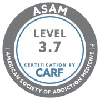What Is Molly?
MDMA (3,4-methylenedioxymethamphetamine) is a synthetic drug altering mood and perception. It’s like the director of your brain’s own movie, working with chemicals like serotonin, dopamine, and norepinephrine. The result? A temporary euphoria that feels like a big happy party – but with a catch.
The Chemistry of Molly
The term “Molly” for MDMA comes from the word “molecular.” In drug culture, “Molly” refers to the supposedly pure crystal powder form of MDMA, which is believed to be a more unadulterated version of the drug compared to Ecstasy, its pill form.
The name “Molly” suggests a molecular level of purity, implying that the substance is the pure form of MDMA without additional additives or fillers that are often found in Ecstasy pills. Of course, this is usually not the case.
Molly works her magic primarily by increasing the activity of three neurotransmitters: serotonin, dopamine, and norepinephrine. Serotonin is best known for its role in mood and emotion.
When Molly arrives, serotonin floods the brain, creating a surge of intense emotional closeness, elevated mood, and amplified sensory perception. It’s like turning up the color saturation on your life’s movie, making everything feel more profound, more significant.
Dopamine and Norepinephrine
Dopamine, the neurotransmitter associated with pleasure and reward, also gets a boost. It’s what you might feel winning a small fortune or falling in love. Norepinephrine, which affects heart rate and blood pressure, ramps up the body’s energy levels. This is why, under Molly’s influence, you feel like you could dance until sunrise.

Molly’s Downside: A Neurochemical Hangover
But Molly’s party doesn’t last forever. The brain, having depleted its serotonin reserves, faces a deficit in the following days. This can lead to feelings of depression, anxiety, and fatigue, like an emotional hangover. Imagine lending all your happiness to one night, and find yourself completely empty the next few days.
Long-Term Effects of Molly
Consistent use of Molly can lead to more than just temporary blues. It can alter the brain’s structure. Repeatedly flooding the brain with serotonin can damage the receptors it binds to, potentially leading to long-term emotional and cognitive challenges.
The Deceptive Nature of Molly
Molly’s allure lies in its ability to create a sense of connection and euphoria, an emotional utopia. But it’s important to remember that this utopia is a chemically manufactured illusion. Like a dream, it feels real and intense, but it’s not a sustainable reality. The true danger of Molly lies in her ability to make us forget that the best connections and the most profound joys are those that are not chemically engineered.
The Addiction
Molly addiction symptoms are sneaky. They start as a whisper—an increasing craving for the drug’s effects or thinking about it for much of your day. You might find yourself using more to get the same high. Or when you don’t have it, you feel anxiety, depression, insomnia, and a profound loss of pleasure in daily life.

Q&A: The Truth About Molly
Q: Is MDMA addictive?
A: In a nutshell, yes. While it may not be as physically addictive as some substances, it has a sly psychological grip.
Q: Can you overdose on MDMA?
A: Absolutely. An overdose can overheat your body, spike your heart rate, and even lead to seizures. It’s like turning your body’s thermostat way too high and then breaking the dial.
Q: Is MDMA a “safe” party drug?
A: Safe and party drug? Rarely do these words fit well together in a sentence. Molly’s risks – dehydration, overheating, heart strain – make it a gamble every time.
Q: Does MDMA have any legitimate medical uses?
A: It’s complicated. While there’s ongoing research into its potential for treating PTSD, it’s not a free pass to self-medicate. Science takes its time for a reason.
Q: What’s the biggest misconception about Molly?
A: That it’s a harmless, fun time. The reality is a complex mix of short-term joy and potential long-term consequences. It’s like eating candy for every meal; fun at first, but you’ll soon regret it.
MDMA may seem like the life of the party, but it’s a guest that overstays its welcome, leaving a mess in its wake. Remember, the best high comes from life’s natural joys – no chemical ticket required.
The Detox Journey: A Road to Recovery
Detox from MDMA is like waking up from a dream and realizing you’re in unfamiliar territory. It’s a process of purging the drug from your system, and it’s as much a psychological journey as it is physical. Medical supervision is key, as they help manage withdrawal symptoms and provide emotional support. It’s a path back to reality, step by cautious step.
Getting Help at Saddleback Recovery
If you or a loved one has been using Molly, it’s time to consider reaching out.
At Saddleback Recovery in Costa Mesa, CA, we understand the complex journey of addiction and the courage it takes to step back from the brink. Our compassionate team offers personalized detox and recovery programs, designed to navigate you safely through the stormy waters of MDMA addiction. Don’t let Molly dictate your life’s rhythm. Call Saddleback Recovery today because you deserve more than just a chemical high.









